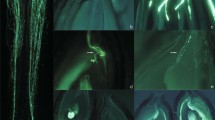Summary
In compatible pollen combinations, viable but infertile irradiated pollen Cr appears to compete much more in a mixture (the mentor pollen situation: C+Cr), than when used one day in advance (the pioneer pollen situation: Cr/C). Seed set of Cr/C was usually also greatly superior to that of C/Cr and, using, self, incompatible pollen S instead of Cr, S/C was nearly always much better than C/S. This is in accordance with the promotion of the second by the first (pioneer) pollen. Hence, when Cr or S are applied second in C/Cr or C/S, more ovules are rendered ineffective (blocked or aborted) than in the reverse combination when Cr or S act as pioneer pollen. These observations are consistent with the trend that the combinations C/ C+S, C+S, C/S tended to produce more selfed seeds in that order. Although mentor or pioneer pollen assist in removing the style barrier for self pollen, embryo abortions appears to be a second obstruction towards seed formation. Indications are that high spring temperature during pollination promote the production of selfed seeds in the presence of compatible pollen. The surfeit of self pollen in orchards with a minority of pollinators is not necessarily an unfavourable factor, it may both directly and indirectly contribute to fruit and seed set.
Similar content being viewed by others
References
Callan, Nancy W. & P. B. Lombard, 1978. Pollination effects on fruit and seed development in ‘Comice’ pear. J. Amer. Soc. Hort. Sci. 103: 496–500.
Dayton D. F., 1974. Overcoming self-incompatibility in apple with killed compatible pollen. J. Amer. Soc. Hort. Sci. 99: 190–192.
Eenink A. H., 1982. Compatibility and incompatibility in witloof-chicory (Cichorum Intybus L.). 3. Gametic competition after mixed pollinations and double pollinations. Euphytica 31: 773–786.
Fuller G. L. & A. C. Leopold, 1975. Pollination and the timing of fruit-set in cucumbers. Hort. Science 10: 617–619.
Gilissen L. J. W., 1977. Style-controlled wilting of the flower. Planta 133: 275–280.
Jong J. de & Y. O. Kho, 1982. The shriveling of pollinated pistils as an aid to rapid determination of Chrysanthemum pollen viability. Euphytica 31: 519–521.
Knox R. B., R. Willing & L. D. Pryor, 1972. Interspecific hybridization in poplars using recognition pollen. Silvae Genet. 21: 65–69.
Nijs A. P. M. den, 1981. Competition for ovules between irradiated and fresh pollen in Cucumis sativus L. Incomp. Newsletter 13: 147–151.
Nijs A. P. M. den & E. H. Oost, 1980. Effect of mentor pollen on pistil-pollen incongruities among species of Cucumis L. Euphytica 29: 267–271.
Stettler R. F. & R. P. Guries, 1976. The mentor pollen phenomenon in black cottonwood. Can. J. Bot. 54: 810–830.
Tuyl J. M. van, M. Clara Marcucci & T. Visser, 1982. Pollen and pollination experiments. VII. The effect of pollen treatment and application method on incompatibility and incongruity in Lilium. Euphytica 31: 613–619.
Visser, T., 1955. Handling of pollen of deciduous fruits (Dutch with English summary). Meded. Dir. Tuinbouw: 856–865.
Visser T., 1981. Pollen and pollination experiments. IV. ‘Mentor pollen’ and ‘pioneer pollen’ techniques regarding incompatibility and incongruity in apple and pear. Euphytica 30: 363–369.
Visser T. & E. H. Oost, 1982. Pollen and pollination experiments. V. An. empirical basis for a mentor pollen effect observed on the growth of incompatible pollen tubes in pear. Euphytica 31: 305–312.
Visser T. & J. J. Verhaegh, 1980. Pollen and pollination experiments. II. The influence of the first pollination on the effectiveness of the second one in apple. Euphytica 29: 385–390.
Williams R. R., R. M. Church, D. E. S. Wood & V. A. Flook, 1979. Use of an anthocyanin progany marker to determine the value of hive pollen dispensers in apple. J. Hort. Sci. 54: 75–78.
Williams R. R. & Maria Maier, 1977. Pseudocompatibility after self-pollination of the apple Cox's Orange Pippin. J. Hort. Sci. 52: 475–483.
Author information
Authors and Affiliations
Rights and permissions
About this article
Cite this article
Visser, T., Verhaegh, J.J., Claramarcucci, M. et al. Pollen and pollination experiments. VIII. The effect of successive pollinations with compatible and self-incompatible pollen in apple and pear. Euphytica 32, 57–64 (1983). https://doi.org/10.1007/BF00036864
Received:
Issue Date:
DOI: https://doi.org/10.1007/BF00036864




